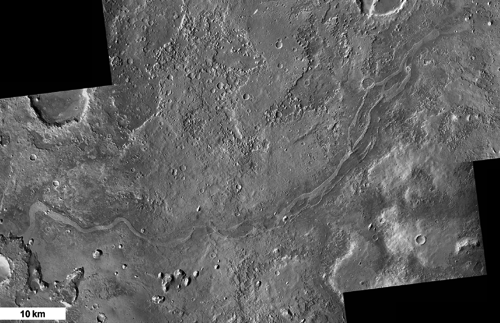- 1Open University, School of Physical Sciences, Milton Keynes, United Kingdom of Great Britain and Northern Ireland (matt.balme@open.ac.uk)
- 2Department of Earth Sciences and Engineering, Imperial College London, London, UK
- 3Department of Earth Sciences, Natural History Museum, London, UK
- 4Space Research Centre, School of Physics and Astronomy, University of Leicester, Leicester, UK
- 5European Space Research and Technology Centre, Noordwijk, Netherlands
- 6Planetary Science Institute, Tucson, AZ, USA
A beneficial outcome of ExoMars Rosalind Franklin Rover (ERFR) 1,2 landing site selection process has been the spinout science from detailed studies of parts of Mars that had not previously been examined in detail. Here, we present the geological description of Aram Dorsum3 (Fig. 1), a well-preserved, flat‐topped, branching, ~85 km long and ~ 1 km wide ridge system in western Arabia Terra that was a ‘top 3’ candidate site during ERFR site selection.

Fig 1. CTX Mosaic Showing Aram Dorsum (sinuous ridge running top right to lower left).
We use morphostratigraphic mapping of the Aram Dorsum ridge and surrounding area, and detailed morphological observations, to propose a consistent working hypothesis for the geological history of the region. Our observations and mapping reveal Aram Dorsum to be the sedimentary deposits of an extensive aggradational fluvial channel belt system, now preserved in positive relief by differential erosion. The existing ridge was once a large river channel belt set in extensive flood plains, many of which are still preserved.
Aram Dorsum is part of a wider set of similar inverted channels found across Arabia Terra4,5, and thus was probably part of a regional fluvial system, demonstrating movement of water and sediment across large distances. Furthermore, several smaller palaeochannel belts feed into the Aram Dorsum ridge from within the local regions, and their setting and network pattern suggest a distributed and local source of water. Aram Dorsum therefore appears to record both regionally and locally distributed sources of water.
Combining mapping with HiRISE6 and CTX7 Digital Elevation Model data reveals that the Aram Dorsum alluvial succession is up to 60 m thick, suggesting a formation time of 105 to 107 years by analogy to Earth8. Correlating our observations with previous regional‐scale mapping9 shows that Aram Dorsum formed in the mid‐Noachian, a result supported by impact crater size frequency distribution measurements.
The Aram Dorsum formation comprises a succession of what are, by analogy with terrestrial fluvial systems, probably coarse‐grained fluvial channel belt sandstones and finer‐grained overbank deposits. The vertical thickness of alluvial succession equates to several cubic kilometres of fluvial sediments in this study region alone. That other inverted channels elsewhere in Arabia Terra4,5,10 are similar in morphology and scale suggest that similar thicknesses and volumes of mid‐Noachian to late‐Noachian fluvial sediments may be extensive and common in the wider region.
Aram Dorsum was an extensive long-lived fluvial system with distributed sources. This suggests that local and regional precipitation (either as rain or as seasonal or repeated snow melt) was the source of water. That Aram Dorsum is one of several similar systems suggests that precipitation was widespread across western Arabia Terra during this period. In contrast, Aram Dorsum's low elevation and distance from the majority of the Valley Networks, argues against the source of water being melting of a distant, high‐altitude, ice sheet, or ice cap11,12. Similarly, the aggradational fluvial depositional setting and the scale of the system do not suggest deposition from multiple short‐lived fluvial flows, as might have occurred due to impact cratering or catastrophic volcanic outgassing temporarily altering the climate12–15. We conclude that Aram Dorsum is one of the oldest fluvial systems described on Mars and indicates climatic conditions that sustained surface river flows on early Mars.
References cited
How to cite: Balme, M., Gupta, S., Davis, J., Fawdon, P., Grindrod, P., Bridges, J., Sefton-Nash, E., and Williams, R.: Aram Dorsum: An Extensive Mid‐Noachian Age Fluvial Depositional System in Arabia Terra, Mars, Europlanet Science Congress 2020, online, 21 Sep–9 Oct 2020, EPSC2020-446, https://doi.org/10.5194/epsc2020-446, 2020.

